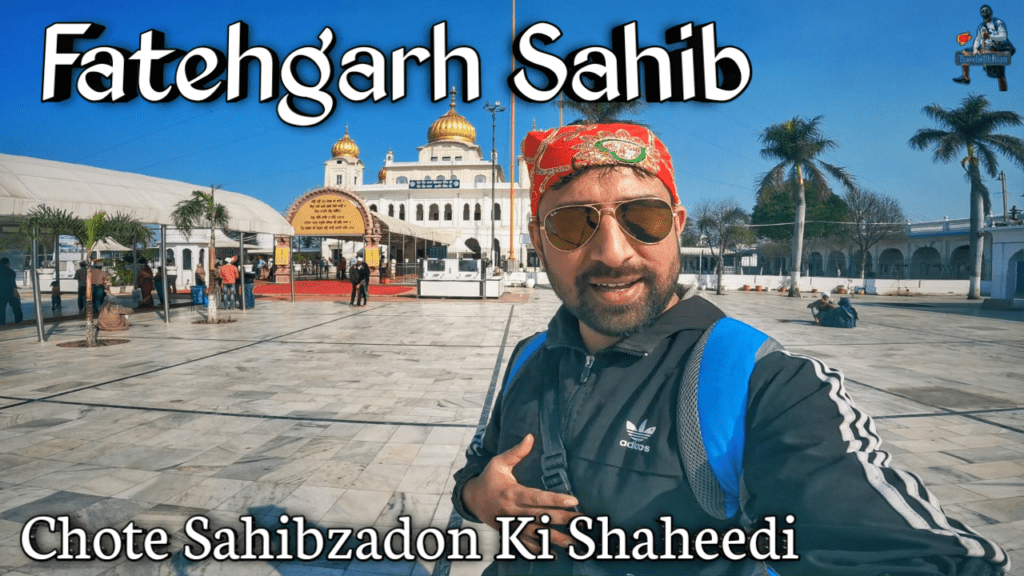Fatehgarh Sahib: The Untold Story of Sacrifices & Resilience


Fatehgarh Sahib: A Sacred Journey Through Faith and History.
The holy pilgrimage destination of Fatehgarh Sahib is located in the centre of Punjab, India. This city honours the unmatched bravery and sacrifice of Guru Gobind Singh’s younger sons, Sahibzada Fateh Singh and Zorawar Singh, as well as his adored mother, Mata Gujri. It holds great historical and religious significance for Sikhs.
For Sikhs, Gurudwara Fatehgarh Sahib—located on the Sirhind-Morinda Road—is a significant place of worship. Sahibzada Fateh Singh and Sahibzada Zorawar Singh, the sons of Guru Gobind Singh Ji, are said to have been bricked alive in 1704 on Wazir Khan’s orders, the Faujdar of Sirhind.
There’s a white marble road that leads from the white stone entrance gate. The Gurudwara’s main structure is adorned with golden domes and white stone constructions, which are hallmarks of Sikh architecture.
Watch my vlog on Fatehgarh Sahib for a visual experience.
Exploring the Gurudwaras:
Fatehgarh Sahib is adorned with several Gurudwaras, each holding immense spiritual significance and architectural beauty. Here are some of the prominent ones that pilgrims should visit:
- Gurudwara Sri Fatehgarh Sahib: The central and most revered Gurudwara, constructed on the site where the Sahibzadas were martyred. The serene sarovar (holy pool) and the ornate architecture offer a peaceful and inspiring ambiance.
- Gurudwara Jyoti Sarup: Located nearby, it honours the cremation of Guru Gobind Singh Ji’s mother, Mata Gujri, and his two younger sons, Sahibzada Zorawar Singh and Sahibzada Fateh Singh. Nobody is said to have donated land for the martyrs’ cremation because of Wazir Khan, Faujdar of Sirhind. For their final ceremonies, Todar Mall, a devout disciple of Guru Gobind Singh Ji, subsequently purchased a tiny plot of land from Chaudary Atta. The Gurudwara’s white structures and domes are its main features.
- Gurudwara Shaheed Ganj: This Gurudwara honours the countless Sikhs who were martyred by the Mughals. It serves as a poignant reminder of the sacrifices made in the fight for religious freedom.
- Gurudwara Shri Thanda Burj: Wazir Khan imprisoned Guru Gobind Singh’s two younger sons, Fateh Singh and Zorawar Singh, together with his mother, at the location of Gurdwara Burj Mata Gujri; the fort was known as “THANDA BURJ.” In the summer, this place is thought to be cool. However, keeping his sons and mother here during the bitter cold was a punishment. When Mata Gujri learned that her grandsons had become martyrs, she broke down at this location. At this location, Gurdwara Shri Thand Burj was subsequently built.
- Gurudwara Bibangarh Sahib:
The location of Gurdwara Sri Bibangarh Sahib is directly behind Gurdwara Sri Fatehgarh Sahib. The brutal martyrdom of Sahibzada Zorawar Singh and Sahibzada Fateh Singh Ji occurred in 1704. The entire scenario was told to Mata Gujri Ji by Bhai Moti Ram Mehra Ji after their martyrdom. Mata Gujri Ji prayed to God and then breathed her last.
In the thick forest behind Gurdwara Sri Fatehgarh Sahib, at the bank of the Hansla River, many untamed creatures may be seen in the jungle. Prior to Todar Mal and others reclaiming the bodies for an appropriate cremation, it is reported that a lion watched over the holy remains. Those holy remains were stored for the night at the site now known as the GurdwaraBibangarh Sahib
- Gurudwara Baba Moti Ram Mehra:The Gurudwara is situated about 660 feet (200 metres) from the prominent Gurdwara Fatehgarh Sahib, another significant holy site associated with the martyrdom of the Sahibzades.Though born a Hindu, Baba Moti Ram Mehra was a devout disciple of Guru Gobind Singh during the Mughal persecution. He put his life in danger to enter the chilly Thanda Burj, where the Mughal governor was holding the younger Sahibzades, Baba Zorawar Singh and Baba Fateh Singh. Baba Moti Ram Mehra sneaked milk to the Sahibzades and their grandmother Mata Gujri, who was also imprisoned with them, for three nights.When his actions were discovered, Baba Moti Ram Mehra was brutally tortured and martyred by the Mughal authorities. To commemorate his selfless service and sacrifice, the Gurudwara was built in his memory.


Diwan Todar Mal


Well-known in Sikh annals, Diwan Todar Mal was not only a prosperous businessman but also a personification of courage and everlasting faith. His tale is closely connected to his beautiful haveli (mansion) in Sirhind, Punjab, which is called the Jahaz Mahal or Jahaz Haveli, which means “Ship Palace.” Diwan Todar Mal is believed to have been a Jain businessman from Fatehgarh Sahib. He held a prestigious position as the Diwan (revenue minister) in the court of Nawab Wazir Khan, the Mughal governor of Sirhind during the 17th century. His wealth and influence were evident in the construction of his grand haveli, renowned for its architectural beauty and opulent design.
Diwan Todar Mal was extremely sympathetic to the situation of the Chote Sahibzade and their grandmother, even though he was a Jain by faith and held the esteemed post of Diwan in the court of Nawab Wazir Khan—the man who ordered the execution. He had to acknowledge the extreme unfairness they were subjected to.
Diwan Todar Mal showed incredible bravery despite being aware of the seriousness of his conduct and the possible consequences. He embarked on a risky undertaking and disobeyed Nawab Wazir Khan’s orders. It was one of the most costly pieces of land ever bought for cremation when he surreptitiously acquired the same plot of land where the execution was to occur at a hefty cost. With this gesture, Sikh rules were followed and the Chote Sahibzade and Mata Gujri were given proper and respectful funeral rites.
Nawab Wazir Khan was so infuriated by Diwan Todar Mal’s disobedience that he was forced to leave Sirhind with his family, leaving behind his wealth and opulent lifestyle. Once a representation of his wealth, his Haveli became known as the Jahaz Haveli, serving as a continual reminder of his valiant self-sacrifice.


Amazing information i got from this vlog … Your presentation is very excellnt .. easy to read , easy to understand , how did that thing happen ..? Good going brother keep writing 💐👏🤞🤞🫂🫂
I appreciate your time and patience, and I hope you like it. Thank you.